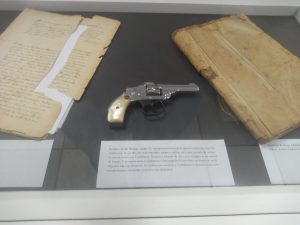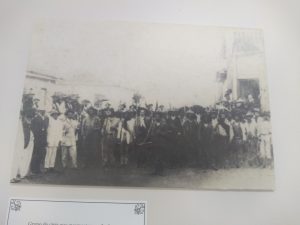The Contestado Valley, where the War of 1912 – 1916 took place, presents the presence of Italian, German and Japanese immigrants, as well as caboclos and indigenous people from the region, creating a place of great cultural plurality that attracts tourists from all regions of Brazil and the world. Recently, on July 4th, 2019, the Regional Government of Vale do Contestado decided to change the name of the region to Vale dos Imigrantes, generating much criticism from researchers and residents of the region. For more information about the change, see the post here. This decision has the main objective of increasing the tourist attractions of the region with economic bias, aiming at increasing regional development. However, there are several culinary festivals, tourist attractions, and other attractions that, with the proper government stimulus to increase resources and expand the infrastructure of the cities, could lead to growth in tourism without changing the name of the region. The following are examples of actions in which the name of Contestado Valley is very well used in several cities:
Main destinations
The Contestado Valley is composed of several municipalities, among which: Treze Tílias, Fraiburgo, Piratuba, Videira, Tangará, Pinheiro Preto, Porto União, Itá, Seara, Frei Rogério and others such as Campos Novos and Curitibanos which, right after BR-116, are the first cities in a vast territory that moves forward to the west of the State of Santa Catarina. Campos Novos and Curitibanos preserve many characteristics of the Santa Catarina mountain range: planes, cattle grazing, campeiro customs and Gaudério’s way of talking and dressing (typical behavior). Joaçaba and Concórdia are progressive cities and main economic centers of the region. The multiplicity of sceneries, people and cultures is the biggest attraction of the region, for example the Austrian city of Treze Tílias, which has many points of visitation.

Portal of the city of Treze Tílias. Source.
The cities of Videira, Tangará and Pinheiro Preto are part of the Wine Valley, colonized mainly by Italians. The wineries of the city of Pinheiro Preto, like the Vinícola da Serra, receive visitors for guided tours and tasting. The temperate climate and the excellent wine make this region a great destination during the winter.
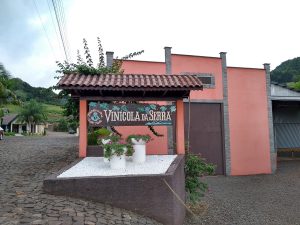
Vinícola da Serra, Pinheiro Preto/SC. Source.
Another great attraction is the city of Piratuba, where the thermal waters, hotels that refer to the Germanic style and water parks allow visitors an unforgettable experience.

Thermal Waters of Piratuba/SC. Source.
For visitors who are interested in knowing the history of the Contestado War, the Museu Histórico e Antropológico da Região do Contestado located in the city of Caçador/SC is a true cultural landmark of permanent information and reflection that keeps the memory of the Contestado Region for future generations.
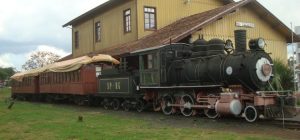
Front of the Museu Histórico e Antropológico da Região do Contestado, Caçador/SC. Source.
Another very interesting place is the Contestado Cemetery, located in the city of Irani/SC, where the victims of the first battle between the caboclos and the troops commanded by the colonels in 1912 are buried, starting the war.

Front of the Cemitério do Contestado, Irani/SC. Source.
Typical parties in Santa Catarina
The vast diversity of municipalities brings with them typical festivals to celebrate the culture of the settlers. Below is the list of cities and festivals:
Campos Novos
In Campos Novos there are six types of CTG Rodeios in the localities of Crossroads District, Pito District, Deer Farm, Good Hope, Model Farm, and Ibicuí District in different months of the year.
Canoinhas
The biggest party in the city, at the Ouro Verde Exhibition Park the State Festival of Erva-Mate (Fesmate). In September.
Butter Festival, in the district of Marcílio Dias. In November.
Shooting Party, at the headquarters of the Clube de Tiro ao Alvo in the Campo d’Água neighborhood. In October.

Shooting Party. Source.
Concordia
National Baked Piglet Festival (FENAL). The National Festival of Roast Piglet is held annually in the city.
Frei Rogério
Sakura Matsuri – Cherry Blossom Festival. In September, early spring.
Fruits of Peace Party. It brings together all the agricultural crops of the region. In the second weekend of February.
Frei Fest. Every two years, between January and February.

Party Sakura Matsuri. Source.
Itá
Feast of gold, at Servita’s Gym. In March.
Anniversary of the City, at Dr. Aldo Ivo Stumpf Square. In December.
Itaiópolis
Grated Meat and Chicken on the Spit Party that celebrates the anniversary of the city. It takes place in October, on structures set up in the streets of the historic neighborhood Alto Paraguaçu.
Polish Night, promoted by the Polish Cultural Association. In August. Feast Room of St. Stanislaus Church. Historical Center of Alto Paraguaçu.
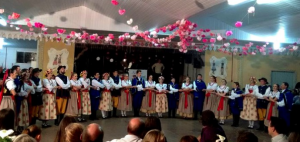
Polish night. Source.
Mafra
Heimfest, typical German party, with music, dancing and local cuisine. Lar dos Velhinhos, 1.120 Gustavo Friedrich Street, Vila Nova. In March.
Bucovinafest, dances, folkloric presentations and typical foods celebrate the tradition of families from Bavaria (Southern Germany). In July.
City’s anniversary celebrations, shows, handicraft fair, typical foods and Producer’s Party. In September.
Piratuba
Hawaii Night, at the Termas de Piratuba complex. In January.
Kerbfest, in the Event Center. In January

Kerbfest. Source.
Porto União
Steinhaeger and Xixo Party: besides the specialties that give the party its name, it serves dishes of German gastronomy. There are also artistic performances, shows and parades. At Espaço Estação União. Hercílio Luz Square, s/n, Centro. In December. www.festadoesteinhaeger.com.br.
Bergbauernfest, it is the Feast of the Mountain Settlers, a typical German event, which rescues Germanic customs and traditions. In the locality of Maratá, 15 km from the center of Porto União. In November.
Vargeão
Italian Sheep Feast and Dinner, held every two years, they celebrate the cultural heritage of immigrants, with emphasis on typical cuisine.
Videira
Harvest Festival, event that celebrates the grape harvest with cultural presentations, followed by a typical Italian dinner. Held every year in the Rondinha community, in January or February.
Expo Videira, shows, cultural presentations, knowledge seminars, business promotion and typical gastronomy. Every two years, at SER BRF Recreational Sports Society. Rua 10 de Setembro, 1.996 – Universitário.
Christmas Decoration, with different themes every year, the magic of Christmas grows in Vine. The Rio do Peixe Park receives special lighting celebrating the coming of Santa Claus. The high points of the party are the Giant Tree and the Little House of Santa Claus. Cultural presentations also make the joy of the public and children.
Anniversary of the Mário de Pellegrin Wine Museum, celebration of the foundation of the Wine Museum and the Canonical House, a building of relevant historical value, with cultural presentations. In September.
Local Gastronomy
The region’s cuisine shows the diversity of the colonizers, who brought with them the typical German and Italian culture and dishes and the food originating from the caboclos. The Flavors of Contest Festival, held by the city of Porto União/SC, enables a gastronomic circuit, where visitors have the opportunity to try several common dishes in the region. Another option for visitors is the Cansian Zamban restaurant located in Lages/SC, which besides the typical Italian cuisine also brings a collection of traditional recipes from the mountain region, such as paçoca de pinhão, entrevero, escondidinho, farofa de carne seca, quirera, feijão tropeiro, aipim frito, cabbage stew, carreteiro rice, feijoada, among others. In the city of Papanduva/SC the typical restaurants of the region serve the roasted lambari (of indigenous origin), the farofa de charque (heritage of the troopers) and the typical Polish recipes, such as the julienne soup (based on cooked vegetables, seasoned and served with cream) and the pierogi (similar to a baked pastry stuffed with ricotta). The oriental descendants who live in Frei Rogério’s town keep the Japanese cuisine alive, among the many prepared foods are Inarizushi, one of the sushi varieties; Makizushi, rice rolls with seaweed and various fillings; Ryugan, a slice of seasoned bread stuffed with boiled egg, spicy flavor; Sakura Mochi: boiled rice dough with red dye spilled with salty cherry leaf; Moti tsuki: rice cake (moti) is punched in the wooden pestle and then distributed to those present at the Sakura Matsuri party. Several people take turns in the work of punching the moti, which symbolizes the human effort to have good luck in the year that is coming; Gings khan: strips of baked beef or sheep on a hot stove. And finally, the wineries of the Wine Valley region, responsible for 50% of all the wine produced in Brazil, close with a golden key the delights of the region. The mixture of German, Italian, Japanese gaucho and tropeira cuisine, among others, attracts many tourists who come to enjoy the delights of the state of Santa Catarina.
The great attractions of the Contestado Valley, which honor the local history and culture, exemplify the possibilities of tourist exploitation in the region, which have resulted in greater economic development and improved the quality of life of residents. The local tourism is deeply connected to the memory of the Contestado War, which is part of the cultural identity and important historical landmark for the residents of the region, evident in many monuments, celebrations and tourist points of the cities in the Santa Catarina Plateau.
Text by Francine Soares de Almeida and Karen Wesseler Jung.
References
ATEMA, Associação do Turismo e Meio Ambiente. Festival Sabores do Contestado. Visite União, 2017. Disponível em: <http://visiteuniao.com.br/festivalsaboresdocontestado/>. Acesso em: 21 maio. 2020.
BALMANT, Evandro Klimpel. Irani – O Berço do Contestado. Blogger Turismo 2 rodas, 2012. Disponível em: <https://www.turismo2rodas.com.br/irani-o-berco-do-contestado/>. Acesso em: 21 de maio. 2020.
Conheça Pinheiro Preto, capital Catarinense do Vinho. Blogger Casa de Roda, 2018. Disponível em: <https://www.casadedoda.com/pinheiro-preto-santa-catarina/>. Acesso em: 21 maio. 2020.
Culinária Campeira e Gaúcha. Turismo Santa Catarina. Disponível em: <http://turismo.sc.gov.br/atividade/culinaria-campeira-e-gaucha/>. Acesso em: 21 maio. 2020.
Festas Típicas. Turismo Santa Catarina. Disponível em: <http://turismo.sc.gov.br/atividade/festas-tipicas/>. Acesso em: 21 maio. 2020.
O que fazer: Piratuba. Blogger Tripadvisor. Disponível em: <https://www.tripadvisor.com.br/Attractions-g2572668-Activities-Piratuba_State_of_Santa_Catarina.html>. Acesso em: 21 maio. 2020.
RIBEIRO, Edison. Águas Termais de Piratuba – SC. Blogger Destino Florianópolis. Disponível em: <http://destinoflorianopolis.com.br/aguas-termais-de-piratuba-sc/>. Acesso em: 21 maio. 2020.
Portal de Turismo de Frei Rogério. Disponível em:<https://turismo.freirogerio.sc.gov.br/equipamento/index/codEquipamento/5786>. Acesso em: 21 maio. 2020.
Site do Restaurante Cansian Zamban. Disponível em: <https://www.cansianzamban.com.br/>. Acesso em: 21 de maio. 2020.
VIANA, Andyara Lima Barbosa. Modelos relacionais para a organização e o desenvolvimento regional do turismo. UNISC, 2012. Disponível em: <https://repositorio.unisc.br/jspui/handle/11624/404>. Acesso em: 21 de maio. 2020.
